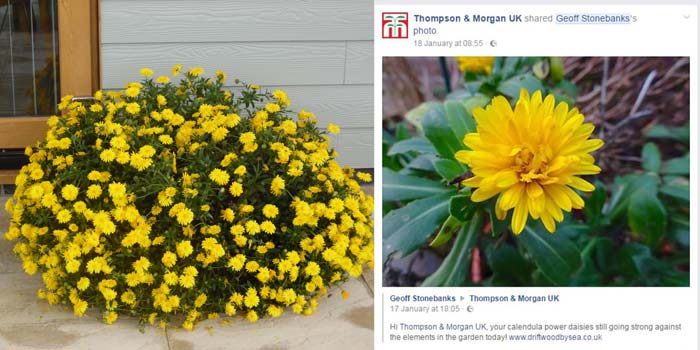
Do your bit to help bees survive the winter - plant the 'Power Daisy'
Winter-flowering plants are vital as a food source for bees.
Planting Thompson & Morgan’s hugely successful hardy annual, Power Daisy, could help bees survive the winter months. On the horticultural mail order company’s website, it states that the Power Daisy flowers from June through to October. However a recent Facebook post by Geoff Stonebanks, gardener, journalist and author, showed that his Power Daisy is incredibly still flowering at the end of January! Geoff said ‘This Power Daisy plant has been flowering constantly since July, and until this last really cold snap, I had seen bees visiting the flowers on various occasions over the winter’.
These stunning bright yellow flowers not only provide gardeners with cheery, unusually vibrant, and much-needed colour through the winter, but they will offer a welcome source of nectar for any bees that venture out to brave the cold.

In recent press articles, we’re told that experts are calling for a nationwide effort to help our dwindling bee population survive through the cold winter months. Whilst these vital pollinators tend to make it through the winter in a state of near hibernation, making food available for them in gardens will improve their chances of surviving until spring. So what can gardeners do to help?
Defra (Department for Food, Environment and Rural Affairs) suggests the obvious - plant flowers, shrubs and trees that thrive in winter. Thompson & Morgan suggests growing the following plants to help support and encourage bees through the cold months until spring:
- Power Daisy (obviously!)
- Mahonia
- Winter-flowering clematis
- Ivy or hedera
- Perennial wallflower, such as Erysimum ‘Bowles Mauve’
It’s also worth thinking ahead and getting some bee-friendly trees and hedging planted. Try acacia and blackthorn, both are very attractive and have the added bonus of being a valuable food source for bees later in the year. And be sure to plant early-flowering spring varieties such as primrose, crocus and snowdrops - these will flower in February and March giving bees and other pollinators a much needed source of food before spring really gets going.
More information on the Power Daisy
More information on attracting bees and other pollinators to the garden
Written by: Sonia Mermagen
Although I love beautiful plants and gardens, I am a self-proclaimed ‘reluctant’ gardener and 
am generally amazed if anything flourishes in my own garden.
I'm a big fan of plants marked ‘easy to grow’, ‘drought tolerant’ and ‘no pruning necessary’ and have had some success over the years with Buddleja ‘Buzz’, Lily ‘Defender’ and Lavender ‘Munstead’. I do enjoy a small, but very tasty annual crop of blueberries from my lone blueberry plant.
Sign Up For Exclusive Special Offers




© 2024 Thompson & Morgan. All rights reserved. A division of Branded Garden Products Limited.



